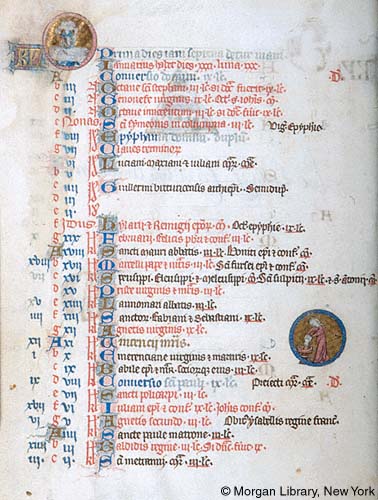
Accession number
MS M.1042
Object title
Breviary fragment (MS M.1042).
Created
Paris, France, 1285-1297.
Binding
Early 19th-century brown calf, covers with blind-stamped panels and borders, each highlighted with gilt rules, six-compartment spine, five with repeated floral gilt stamp, one with red morocco label.
Credit line
Purchased on the Fellows Fund, with the special assistance of Mrs. W. Rodman Fay, 1983.
Description
101 leaves (2 columns, 25 lines), bound : vellum, ill. ; 192 x 125 mm
Provenance
Nicolo de Vercenne; "Maximilien" (note on fol. 1); Pierre Gelis-Didot (bookplate); his sale, Paris, Librairie Théophile Belin, Apr. 12-13, 1897, lot 6; Henry Yates Thompson, Ms. 72) (bookplate); Anne-Marie Huth Jackson; John A. Saks; his sale, New York, Christie's, May 20, 1983, lot 48.
Notes
Ms. breviary for the use of Sainte-Chapelle (calendar); written and illuminated in Paris, France, between 1285 and 1297 (Calendar is dated between 1285, which marks the death of King Philip III (his calendar obit), and 1297, the canonization of King Louis of France [Louis IX], may have been commissioned by Marie of Brabant, widow of Philip III or Joan I of Navarre, wife of Philip IV the Fair).
Calendar includes three feasts, Dedicatio capelle regis parisiensis (04.26), Susceptio sancte corone domini (08.11), and Susceptio reliquiarum in capellam regis (09.30), and commemorates numerous feasts of Parisian saints.
Calendar mentions obits of Louis VII of France (1180.09.19), Philip Augustus (1223.07.14), Obitus interfectorum in Egypto a Saracenis (1249.04.07), Isabella of Aragon (1271.01.28), and Philip III of France (Le Hardi) (1285.10.06), husband of Marie of Brabant.
Decoration: 8 historiated initials with marginal extensions, some with anthropomorphic terminals, 24 calendar illustrations (occupations for the months and the signs of the zodiac).
Artists: probably illuminated by the artists of the so-called Breviary of Philip the Fair (Paris, BNF, Ms Latin 1023)--Cf. Twentieth report to the Fellows of the Pierpont Morgan Library, 1984. François Avril attributed the Trinity (fol. 92v) to the Master of Méliacin (see, L'art au temps des rois maudits, 1998, no. 189). Alison Stones considers the Beatus initial (fol. 8r) close to the style of the Master of the Life of St. Benedicta of Origny (see, A. Stones, Gothic Manuscripts, 2013, no. I-2, Cat. 44).
Some of the subjects in the historiated initials are related to those in the Breviary of Philip IV the Fair (Paris, BNF Ms. Latin 1023): Psalm 26 (M. 1042, fol. 21r and BNF, Ms Latin 1023, fol. 16r) David before hostile fortress; Psalm 38 (M. 1042, fol. 29v and BNF, Ms. Latin 1023, fol. 21) David and Miser; Psalm 80 (M. 1042, fol. 56r and BNF, Ms Latin 1023, fol. 36v) David playing bells and Jews adoring Golden Calf.
Revised: 2017
Calendar includes three feasts, Dedicatio capelle regis parisiensis (04.26), Susceptio sancte corone domini (08.11), and Susceptio reliquiarum in capellam regis (09.30), and commemorates numerous feasts of Parisian saints.
Calendar mentions obits of Louis VII of France (1180.09.19), Philip Augustus (1223.07.14), Obitus interfectorum in Egypto a Saracenis (1249.04.07), Isabella of Aragon (1271.01.28), and Philip III of France (Le Hardi) (1285.10.06), husband of Marie of Brabant.
Decoration: 8 historiated initials with marginal extensions, some with anthropomorphic terminals, 24 calendar illustrations (occupations for the months and the signs of the zodiac).
Artists: probably illuminated by the artists of the so-called Breviary of Philip the Fair (Paris, BNF, Ms Latin 1023)--Cf. Twentieth report to the Fellows of the Pierpont Morgan Library, 1984. François Avril attributed the Trinity (fol. 92v) to the Master of Méliacin (see, L'art au temps des rois maudits, 1998, no. 189). Alison Stones considers the Beatus initial (fol. 8r) close to the style of the Master of the Life of St. Benedicta of Origny (see, A. Stones, Gothic Manuscripts, 2013, no. I-2, Cat. 44).
Some of the subjects in the historiated initials are related to those in the Breviary of Philip IV the Fair (Paris, BNF Ms. Latin 1023): Psalm 26 (M. 1042, fol. 21r and BNF, Ms Latin 1023, fol. 16r) David before hostile fortress; Psalm 38 (M. 1042, fol. 29v and BNF, Ms. Latin 1023, fol. 21) David and Miser; Psalm 80 (M. 1042, fol. 56r and BNF, Ms Latin 1023, fol. 36v) David playing bells and Jews adoring Golden Calf.
Revised: 2017
Contents
fols. 1v-7r: Calendar -- fols. 8r-87: Psalter, with Hymn Nocte surgentes -- fols. 87v-89v: Canticles -- fols. 89v-91v: Litany, followed by three collects -- fols. 92r-101: Temporale of Summer portion, beginning with First Vespers of Trinity Sunday. This breviary lacks 27 leaves: one before the calendar; 10 between fols. 68 and 69 containing the end of psalm 103 and psalms 104 to 113; 3 leaves between fols. 69 and 79 containing psalm 117 and the beginning of psalm 118; and 13 leaves between fols. 78 and 79 containing the end of psalm 119, psalms 120 to 127, the canticle "Audite coeli loquor," and the beginning of psalm 128.
Script
textura
Language
Latin
Resources
Century
Catalog link
Classification
Department
